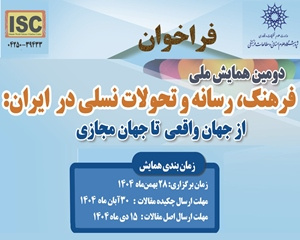خاستگاه تفسیرپذیری قرآن کریم و لوازم معرفتی آن (مقاله علمی وزارت علوم)
درجه علمی: نشریه علمی (وزارت علوم)
آرشیو
چکیده
این مقاله به بررسی تأثیر تفسیرپذیری قرآن کریم بر فهم معرفت دینی و منشاء آن پرداخته است. در این رابطه، با روش تحلیلی و مراجعه به آیات و روایات، ویژگی های قرآن کریم از نظر تفسیرپذیری را بررسی کرده است. نتایج این تحقیق از دو خاستگاه اصلی برای تفسیرپذیری قرآن کریم ، یعنی ابهام روشمند و داشتن ابعاد مختلف معنایی پرده برمی دارد. خاستگاه اول، روش های خاصی مثل اکتفا به بیان کلیات و روش محکم و متشابه و روش های مشابه را در بر دارد که قرآن کریم به سبب اهداف خاص، از طریق آن با مردم سخن گفته است. این امر موجب شده که زمینه های تفسیر به رأی فراهم شده، افراد غرض ورز یا ناآگاه به روش درست تفسیر قرآن کریم ، در معرض فهم های نادرست قرار گیرند. از این نظر، هشدار لازم در متون دینی داده، راه درستِ تفسیر بیان شده است. خاستگاه دوم، ابعاد مختلف معنایی قرآن کریم است که شامل دو نوع هم عرض و طولی است. این امر زمینه را برای فهم های درست هم عرض و طولی فراهم می کند. فهم های هم عرض یا حاصل رویکردهای مختلف به قرآن کریم است که تفسیرهای مختلف عرفانی، اجتماعی، ادبی و غیره را پدید آورده است، یا از طریق جری و تطبیق بر مفاهیم و مصادیق جدید شکل می گیرد. اما فهم های طولی در دو بُعد معانی ظاهری و باطنی شکل می گیرد. بر طبق روایات، مراتب معانی ظاهری ابعاد مختلفی دارد که از فهم عبارات شروع و تا فهم تفسیری و اشاری ادامه می یابد که آگاهان به شیوه تفسیر و رموز آن، می توانند آن ها را استنباط کنند. مراتب معانی باطنی که از ظاهر لفظ استخراج نمی شود، نهایتی ندارد و برای اولیاءالله و انبیای الهی از طریق تأویل عرفانی و علم لدنی مکشوف می شود.The Origin of Interpretability of the Holy Quran and Its Epistemological Tools
This article examines the effect of interpretability of the Holy Quran on the understanding of religious knowledge and its origin. In this regard, by analytical method and referring to verses and hadiths, he has examined the characteristics of the Holy Quran in terms of interpretability. The results of this research reveal two main origins for the interpretability of the Holy Qur'an, i.e. methodological ambiguity and having different semantic dimensions. The first origin includes special methods such as limiting the expression of generalities and the firm and similar method and similar methods through which the Holy Quran spoke to the people due to specific purposes. This has caused the fields of interpretation to be provided, selfish or ignorant people are exposed to misunderstandings. From this point of view, the necessary warning has been given in the religious texts, the correct way of interpretation has been stated. The second origin is the different semantic dimensions of the Holy Quran, which include two types of width and length. This provides the basis for correct understandings of latitude and longitude. Parallel understandings are either the result of different approaches to the Holy Qur'an, which have created different mystical, social, literary, etc. interpretations, or they are formed through adaptation and adaptation to new concepts and examples. But longitudinal understandings are formed in two dimensions of external and internal meanings. According to traditions, the level of apparent meanings has different dimensions, which starts from the understanding of phrases and continues to the understanding of interpretation and allusion, which those who know about the way of interpretation and its secrets, can infer them. The levels of inner meanings that cannot be extracted from the appearance of the word are endless and are revealed to the saints and divine prophets through mystical interpretation and science.








